Experimental Study on the Mechanical and Acoustic Characteristics of Cemented Backfill with Unclassified Tailings at Different Curing Ages under Uniaxial Compression
Abstract
1. Introduction
2. Materials and Methods
2.1. Test Material and Preparation
2.2. Testing Device Equipment
3. Results and Discussion
3.1. Backfill Mechanics Characteristics
3.2. Acoustic Signal Ringing Count Characteristics
3.3. Acoustic Signal ib Value Characteristics
3.4. Spectral Evolution Characteristics of Acoustic Signals
- (a)
- Compaction stage (stage I): The original micro-fractures inside the backfill start to be compressed at this stage, and the acoustic emission signal is not generated. The backfill with a cement–sand ratio of 1:4 has a better structural denseness due to the increase of the cementitious agent content, so the FAE does not exist in the compacting stage.
- (b)
- Crack stable growth (stage II): In this stage, the original micro-cracks inside the backfill are basically closed, and new cracks begin to sprout and develop. The total strain energy absorbed by the filler is mainly stored in the form of elastic energy inside the backfill; the acoustic emission signal begins to increase, and FAE begins to appear in the fI, fII or fI, fIII frequency band. In addition, with the prolongation of the curing age and the amount of C-S-H gel, the internal hydration reaction product of the backfill increases, and the internal structure becomes denser. The bonding force between the particles increases, and the crack expansion pattern becomes complex. the number of FAE starts to increase. The backfill with a cement–tailing ratio of 1:8, due to the increase of the tail–sand content, does not have a sufficient hydration reaction in the early curing stage, which makes the acoustic emission signal more complex at this stage, and increases the FAE in the fI band.
- (c)
- Crack unsteady growth (stage III): An accelerated development of the internal cracks in backfill forms at this stage, and the FAE starts to surge. The FAE appears in the three frequency bands of fI, fII, and fIII, and the three frequency bands are connected to each other to form a wider band in some time periods, indicating that the acoustic emission signal mode becomes more complex, and the crack evolution inside the backfill is more intense.
- (d)
- Post-peaking phase (stage IV): At this stage, the internal crack of the backfill expands and penetrates rapidly, which eventually leads to the complete destruction of the backfill, and the FAE appears intensively in all three bands. The backfill with a cement–tailing ratio of 1:8, due to an increase of the tail–sand ratio, displays friction between the particles after destruction is more intense, causing FAE to start to appear in the fIV band.
3.5. Evolution Characteristics of Class A and B Signals in the Failure Process of Backfill
4. Conclusions
- (1)
- Under the condition of uniaxial compression, with an increase of the curing age, the slope of the straight section of the stress–strain curve of the backfill increases, and the peak load increases. The peak strength and elastic modulus of the backfill are positively correlated with the curing age.
- (2)
- During the failure process of backfill, the acoustic emission ringing count shows a trend of “stabilizing–rising–falling–rising”, and the infrasound ringing count will show a “multi-peak” phenomenon. The acoustic ib value shows a certain regularity in the process of backfill failure, and the ib value begins to decline in a jumping manner when it is close to failure. With the increase of the curing age, the stress percentage corresponding to ibmax increases.
- (3)
- The dominant frequency ratio of the acoustic emission signal (FAE) during the damage of backfill is mainly distributed between 0~3. The dominant frequency ratio of the infrasound signal (FS) is mainly distributed between 0~6.
- (4)
- The ratio of the number of class A and B signals of the acoustic emission in the damage process of backfill is increases. The class A and B signals of the infrasound show a phenomenon of “decrease–increase–decrease”. The ratio of the number of class A and B of the acoustic emission signal and the infrasound signal in the crack’s unsteady growth will show a surge phenomenon.
Author Contributions
Funding
Institutional Review Board Statement
Informed Consent Statement
Data Availability Statement
Acknowledgments
Conflicts of Interest
References
- Jafari, M.; Shahsavari, M.; Grabinsky, M. Drained triaxial compressive shear response of cemented paste backfill (CPB). Rock Mech. Rock Eng. 2021, 54, 3309–3325. [Google Scholar] [CrossRef]
- Tang, Y.; Zheng, J.; Guo, L.; Zhao, Y. Effect of gypsum addition on the mechanical and microstructural performance of sulphide-rich cemented paste backfill. Minerals 2021, 11, 283. [Google Scholar] [CrossRef]
- Zhang, Y.; Feng, X.T.; Yang, C.; Zhang, X.; Sharifzadeh, M.; Wang, Z. Fracturing evolution analysis of Beishan granite under true triaxial compression based on acoustic emission and strain energy. Int. J. Rock Mech. Min. Sci. 2019, 117, 150–161. [Google Scholar] [CrossRef]
- Zhang, Y.; Zhao, G.F.; Li, Q. Acoustic emission uncovers thermal damage evolution of rock. Int. J. Rock Mech. Min. Sci. 2020, 132, 104388. [Google Scholar] [CrossRef]
- Cheng, A.; Zhang, Y.; Dai, S.; Dong, F.; Zeng, W.; Li, D. Space-time evolution of acoustic emission parameters of cemented backfill and its fracture prediction under uniaxial compression. Rock Soil Mech. 2019, 40, 2965. [Google Scholar]
- Xu, W.; Cao, Y.; Liu, B. Strength efficiency evaluation of cemented tailings backfill with different stratified structures. Eng. Struct. 2019, 180, 18–28. [Google Scholar] [CrossRef]
- Marsden, O.; Bogey, C.; Bailly, C. A study of infrasound propagation based on high-order finite difference solutions of the Navier-Stokes equations. J. Acoust. Soc. Am. 2014, 135, 1083–1095. [Google Scholar] [CrossRef]
- Zhou, Q.; Liu, J.; Wu, A.; Wang, H.J. Early-age strength property improvement and stability analysis of unclassified tailing paste backfill materials. Int. J. Miner. Metall. Mater. 2020, 27, 1191–1202. [Google Scholar] [CrossRef]
- Chen, X.; Shi, X.; Zhou, J.; Li, E.; Qiu, P.; Gou, Y. High strain rate compressive strength behavior of cemented paste backfill using split Hopkinson pressure bar. Int. J. Min. Sci. Technol. 2021, 31, 387–399. [Google Scholar] [CrossRef]
- Liu, L.; Fang, Z.; Qi, C.; Zhang, B.; Guo, L.; Song, K.I. Experimental investigation on the relationship between pore characteristics and unconfined compressive strength of cemented paste backfill. Constr. Build. Mater. 2018, 179, 254–264. [Google Scholar] [CrossRef]
- Xue, G.; Yilmaz, E.; Song, W.; Yilmaz, E. Influence of fiber reinforcement on mechanical behavior and microstructural properties of cemented tailings backfill. Constr. Build. Mater. 2019, 213, 275–285. [Google Scholar] [CrossRef]
- Lu, H.; Liang, P. Mechanical behaviour and failure characteristics of cemented paste backfill under lateral unloading condition. Int. J. Min. Miner. Eng. 2020, 11, 66–83. [Google Scholar] [CrossRef]
- Li, M.; Liu, X.; Liu, X. Infrasound signal classification based on spectral entropy and support vector machine. Appl. Acoust. 2016, 113, 116–120. [Google Scholar] [CrossRef]
- Kui, Z.; Zeyuan, Y.; Peng, Z. Infrasound characteristics of cemented tailing filling material under uniaxial compression. J. China Coal Soc. 2019, 44, 92–100. [Google Scholar]
- Qiao, C.; Xu, F.; Su, P.; Liu, Y.; Zhang, Y.; Zhu, H.; Huang, H.; Huang, M.; Chen, J.; Liu, D. Experimental Study on the Features of Infrasonic Waves of Sandstone under Shear Load. Appl. Sci. 2021, 11, 11552. [Google Scholar] [CrossRef]
- Chai, S.; Li, L.J.; Ju, Z.Q.; Zou, Y.; Zhang, Y.Z. Test research on infrasound wave of granite damage course under dynamic uniaxial compression. In Key Engineering Materials; Trans Tech Publications Ltd.: Wollerau, Switzerland, 2011; Volume 460, pp. 692–697. [Google Scholar]
- Zhu, X.; Xu, Q.; Zhou, J.; Tang, M. Experimental study of infrasonic signal generation during rock fracture under uniaxial compression. Int. J. Rock Mech. Min. Sci. 2013, 60, 37–46. [Google Scholar] [CrossRef]
- Jia, B.; Wei, J.; Wen, Z.; Wang, Y.G.; Jia, L.X. The analysis of energy characteristics of infrasonic signal in coal sample with different strength under loading process. Acta Acust. United Acust. 2017, 103, 795–802. [Google Scholar] [CrossRef]
- Liu, X.; Liu, Z.; Li, X.; Gong, F.; Du, K. Experimental study on the effect of strain rate on rock acoustic emission characteristics. Int. J. Rock Mech. Min. Sci. 2020, 133, 104420. [Google Scholar] [CrossRef]
- Du, K.; Li, X.; Tao, M.; Wang, S. Experimental study on acoustic emission (AE) characteristics and crack classification during rock fracture in several basic lab tests. Int. J. Rock Mech. Min. Sci. 2020, 133, 104411. [Google Scholar] [CrossRef]
- Yang, J.; Mu, Z.L.; Yang, S.Q. Experimental study of acoustic emission multi-parameter information characterizing rock crack development. Eng. Fract. Mech. 2020, 232, 107045. [Google Scholar] [CrossRef]
- Huang, Y.; Yang, W.; Zhao, A.; Guo, W. Shear Strength and Re-Failure Characteristics of Intact Red Sandstone and Grouting-Reinforced Body of Fractured Red Sandstone under Different Shear Angles. Minerals 2022, 12, 1580. [Google Scholar] [CrossRef]
- Zhao, K.; Yu, X.; Zhu, S.; Yan, Y.; Zhou, Y.; He, Z.; Song, Y.; Huang, M. Acoustic emission fractal characteristics and mechanical damage mechanism of cemented paste backfill prepared with tantalum niobium mine tailings. Constr. Build. Mater. 2020, 258, 119720. [Google Scholar] [CrossRef]
- Lv, H.; Peng, K.; Shang, X.Y.; Wang, Y.Q.; Liu, Z.P. Experimental research on the mechanical and acoustic emission properties of layered sandstone during tensile failure. Theor. Appl. Fract. Mech. 2022, 118, 103225. [Google Scholar] [CrossRef]
- Sun, L.; Long, Y.; Li, X.; Jiang, Z.; Fan, Y.; Wang, Z.; Han, X. Effect of Loading Rate on the Mechanical Properties of Weakly Cemented Sandstone. Sustainability 2023, 15, 2750. [Google Scholar] [CrossRef]
- Xu, X.; Zhou, Y.; Chen, W.; Gao, Y.; Fu, Q.; Liu, X.; Feng, C. Macro-Microscopic Deterioration Behavior of Gypsum Rock after Wetting and Its Constitutive Model Based on Acoustic Emission. Minerals 2022, 12, 1168. [Google Scholar] [CrossRef]
- Zhao, K.; Yu, X.; Zhu, S.; Zhou, Y.; Wang, Q.; Wang, J. Acoustic emission investigation of cemented paste backfill prepared with tantalum–niobium tailings. Constr. Build. Mater. 2020, 237, 117523. [Google Scholar] [CrossRef]
- Huang, C.; He, W.; Lu, B.; Wang, M.; Li, S.; Xiao, C. Study on Acoustic Emission and Coda Wave Characteristics of Layered Cemented Tailings Backfill under Uniaxial Compression. Minerals 2022, 12, 896. [Google Scholar] [CrossRef]
- Qiu, H.; Zhang, F.; Liu, L.; Huan, C.; Hou, D.; Kang, W. Experimental study on acoustic emission characteristics of cemented rock-tailings backfill. Constr. Build. Mater. 2022, 315, 125278. [Google Scholar] [CrossRef]
- Wang, J.; Fu, J.; Song, W.; Zhang, Y.; Wang, Y. Mechanical behavior, acoustic emission properties and damage evolution of cemented paste backfill considering structural feature. Constr. Build. Mater. 2020, 261, 119958. [Google Scholar] [CrossRef]
- Zhang, H.; Guo, W. Acoustic Emission Waveform Characteristics of Red Sandstone Failure under Uniaxial Compression after Thermal Damage. Sustainability 2022, 14, 13285. [Google Scholar] [CrossRef]
- Li, J.; Huang, Y.; Qi, W.; Kong, G.; Song, T. Loose gangues backfill body’s acoustic emissions rules during compaction test: Based on solid backfill mining. Comput. Model. Eng. Sci. 2018, 115, 85–103. [Google Scholar]
- Hou, Y.Q.; Yin, S.H.; Cao, Y.; Dai, C.Q. Analysis of damage characteristics and energy dissipation of cemented tailings backfill with different curing ages under uniaxial compression. J. Cent. South Univ. Sci. Technol. 2020, 7, 1955–1965. [Google Scholar]
- Zhao, K.; Wang, X.; Wang, L.; Zeng, P.; Yang, D.; Jin, J. Investigation of the crack and acoustic emission behavior evolution of red sandstone subjected to water. Theor. Appl. Fract. Mech. 2022, 120, 103419. [Google Scholar] [CrossRef]
- Colombo, I.S.; Main, I.G.; Forde, M.C. Assessing damage of reinforced concrete beam using “b-value” analysis of acoustic emission signals. J. Mater. Civ. Eng. 2003, 15, 280–286. [Google Scholar] [CrossRef]
- Tayfur, S.; Alver, N.; Saatci, S. Evaluation of acoustic emission activities in a steel fiber reinforced concrete beam by Ib value analysis. J. Fac. Eng. Archit. Gazi Univ. 2019, 2019, 309–318. [Google Scholar]
- Hong, F. Non-Stationary Signal Feature Extraction Method and Its Application; Science Publishing Company: Beijing, China, 2013; pp. 125–134. [Google Scholar]
- Jia, X.N. Experimental Study on Acoustic Emission Eigen-Frequency Spectrum Features of Strain Bursts. Ph.D. Thesis, University of Mining and Technology, Beijing, China, 2013. [Google Scholar]
- Mei, F.; Hu, C.; Li, P.; Zhang, J. Study on main Frequency precursor characteristics of Acoustic Emission from Deep buried Dali Rock explosion. Arab. J. Geosci. 2019, 12, 1–11. [Google Scholar] [CrossRef]
- Nan, L.; Enyuan, W.; Enlai, Z.; Yankun, M.; Fule, X.; Weihua, Q. Experiment on acoustic emission of rock damage and fracture under cyclic loading and multi-stage loading. J. China Coal Soc. 2010, 35, 1099–1103. [Google Scholar]
- Zhang, Y.B.; Liang, P.; Sun, L.; Tian, B.Z.; Yao, X.L.; Liu, X.X. Spectral characteristics of AE in the process of saturated granite fracture under uniaxial compression. Rock Soil Mech. 2019, 40, 2497–2506. [Google Scholar]

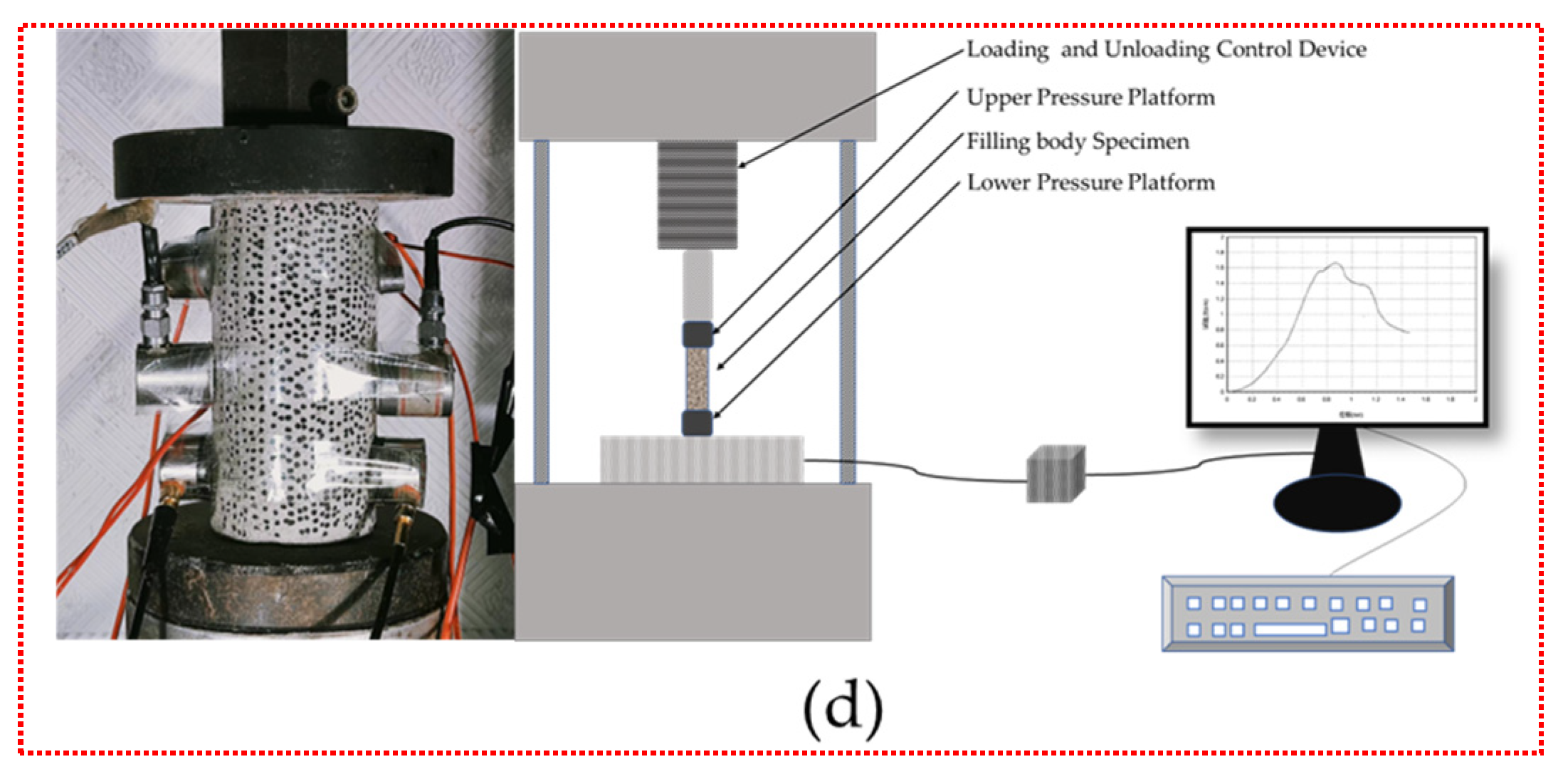

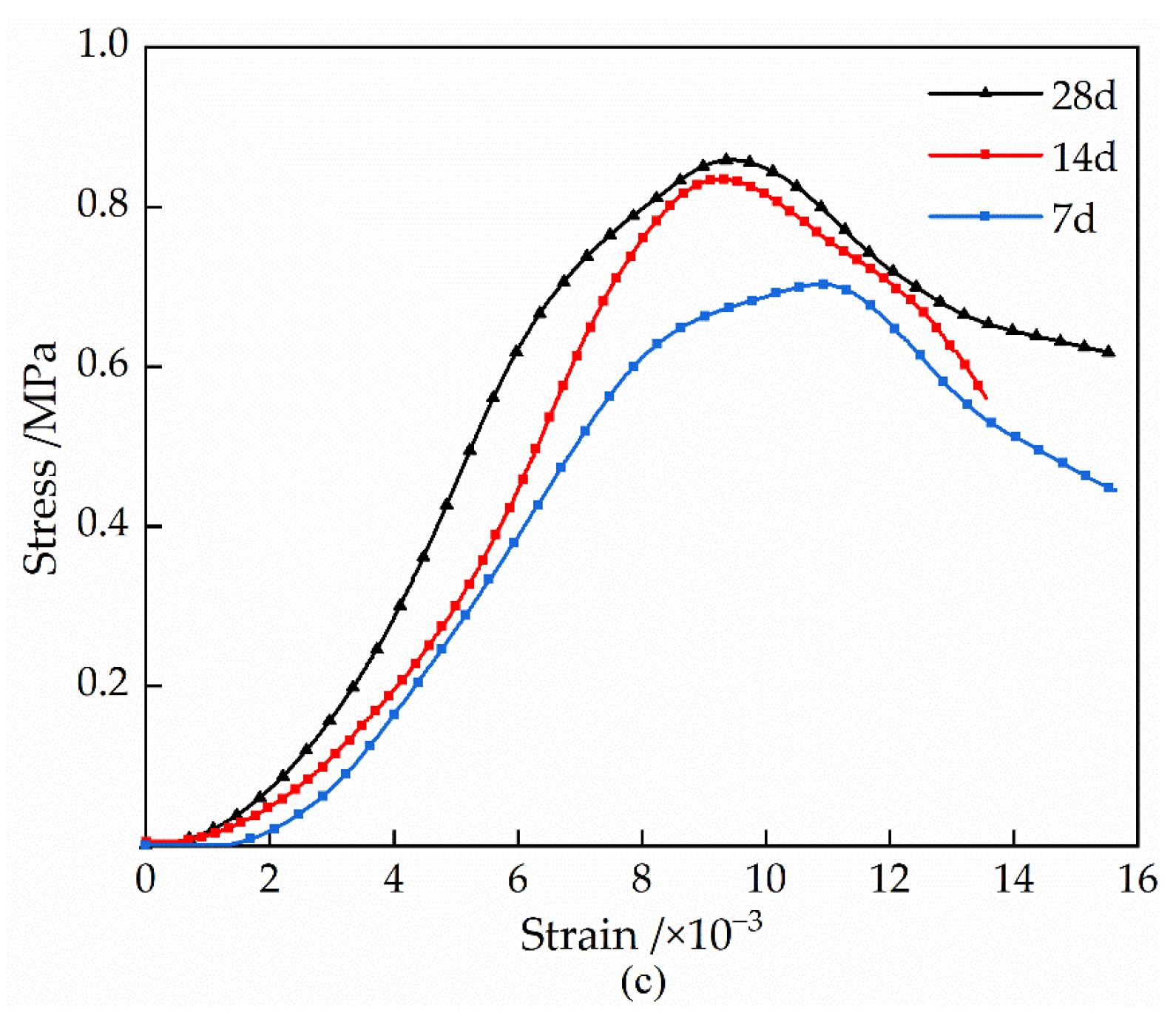
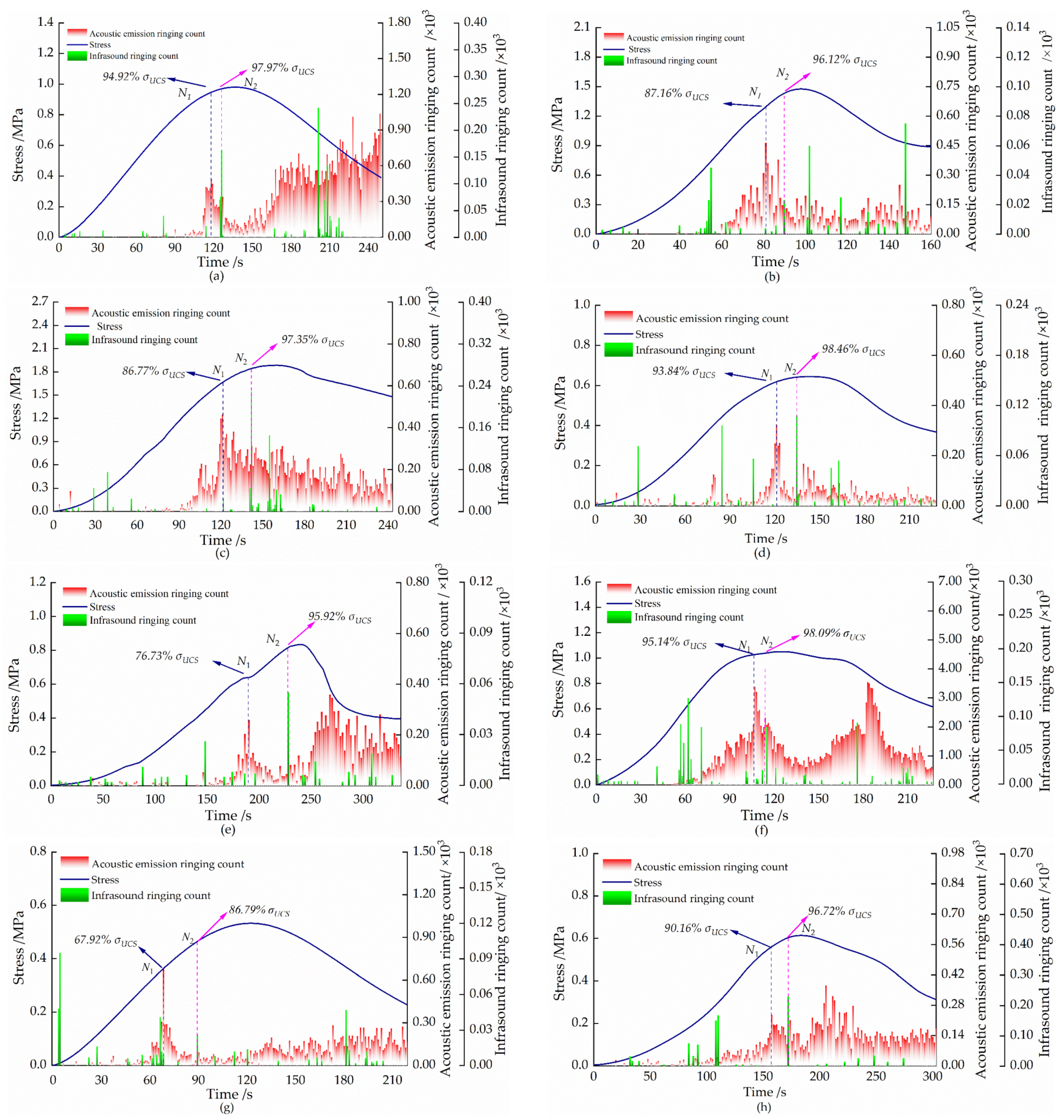
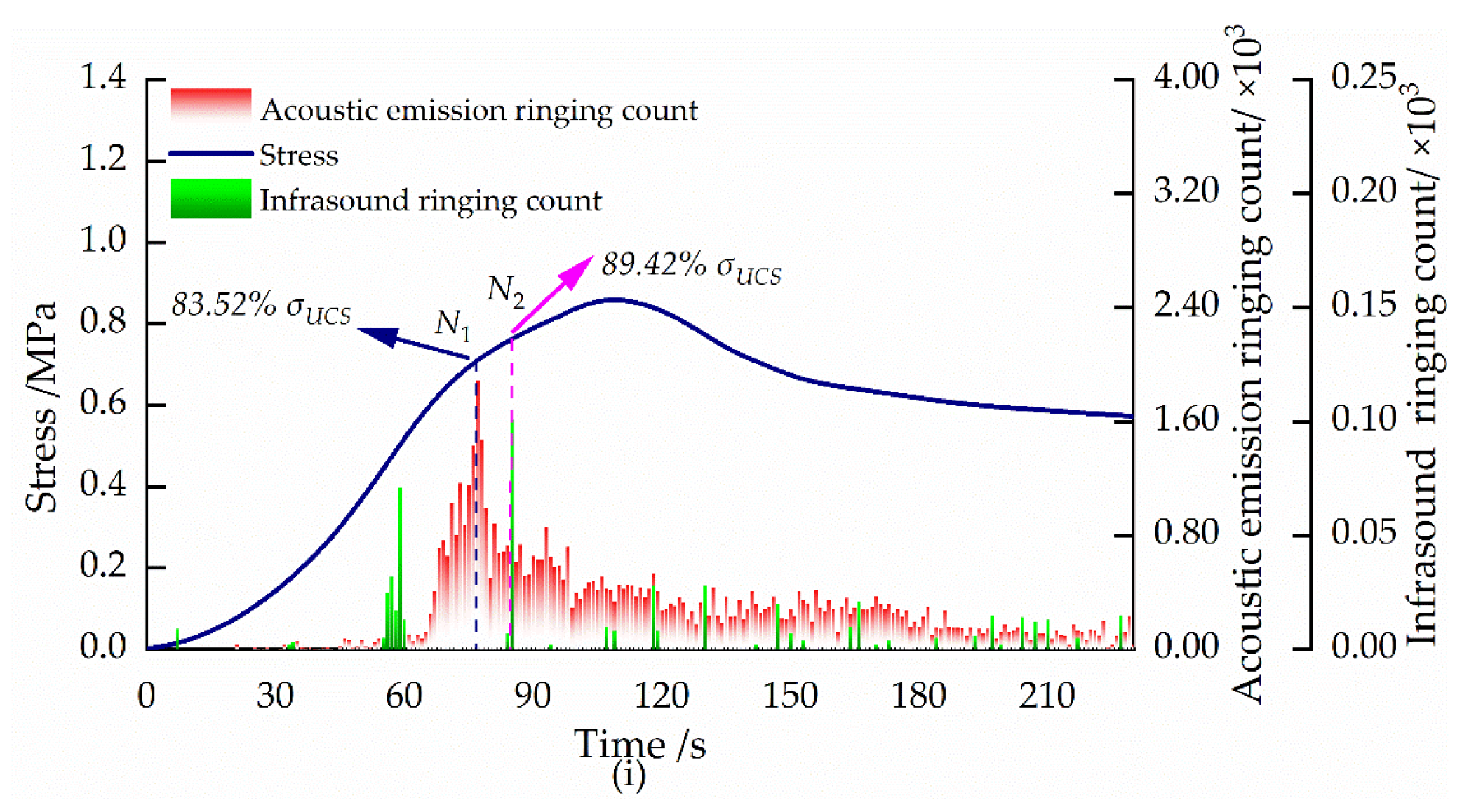
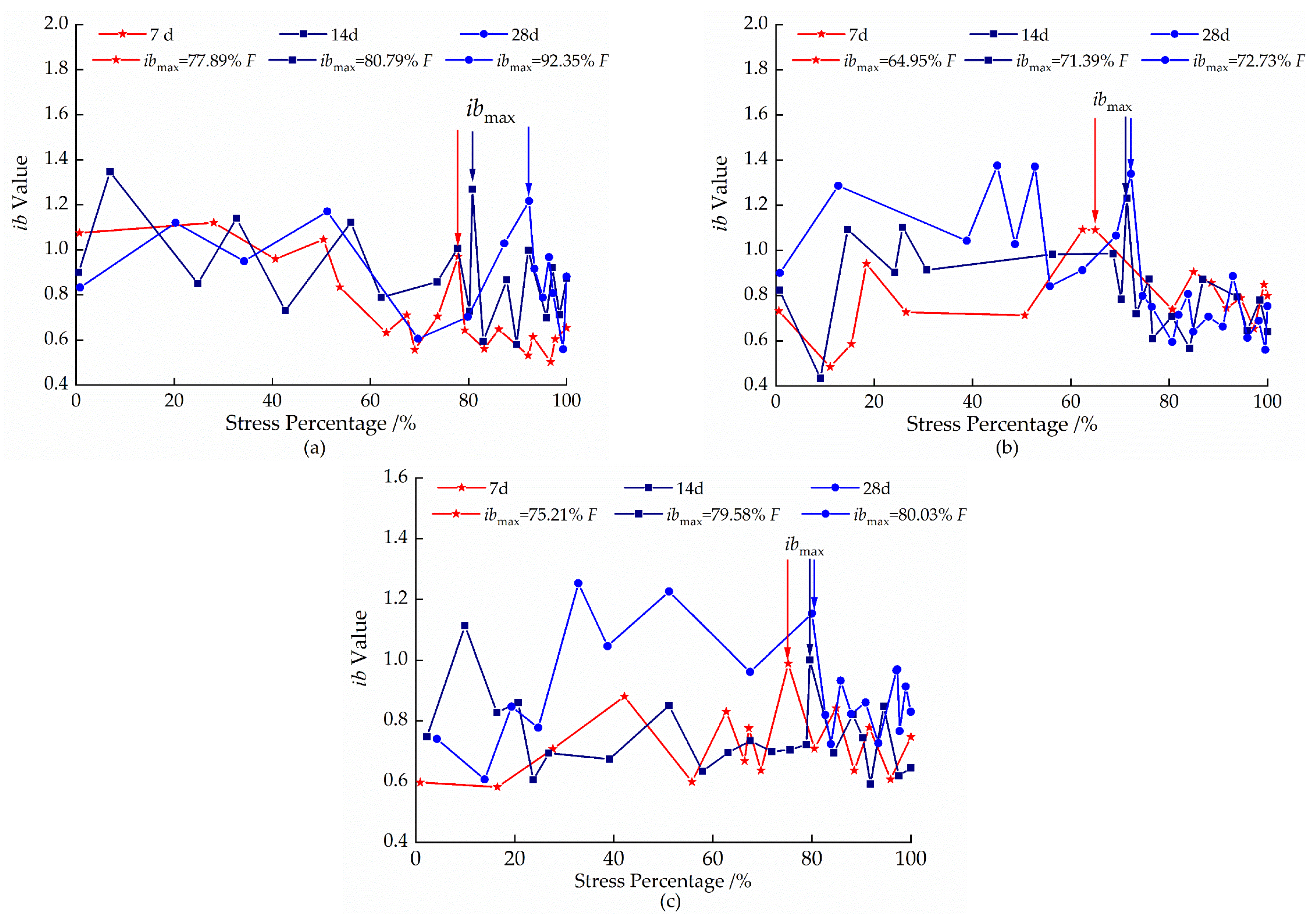

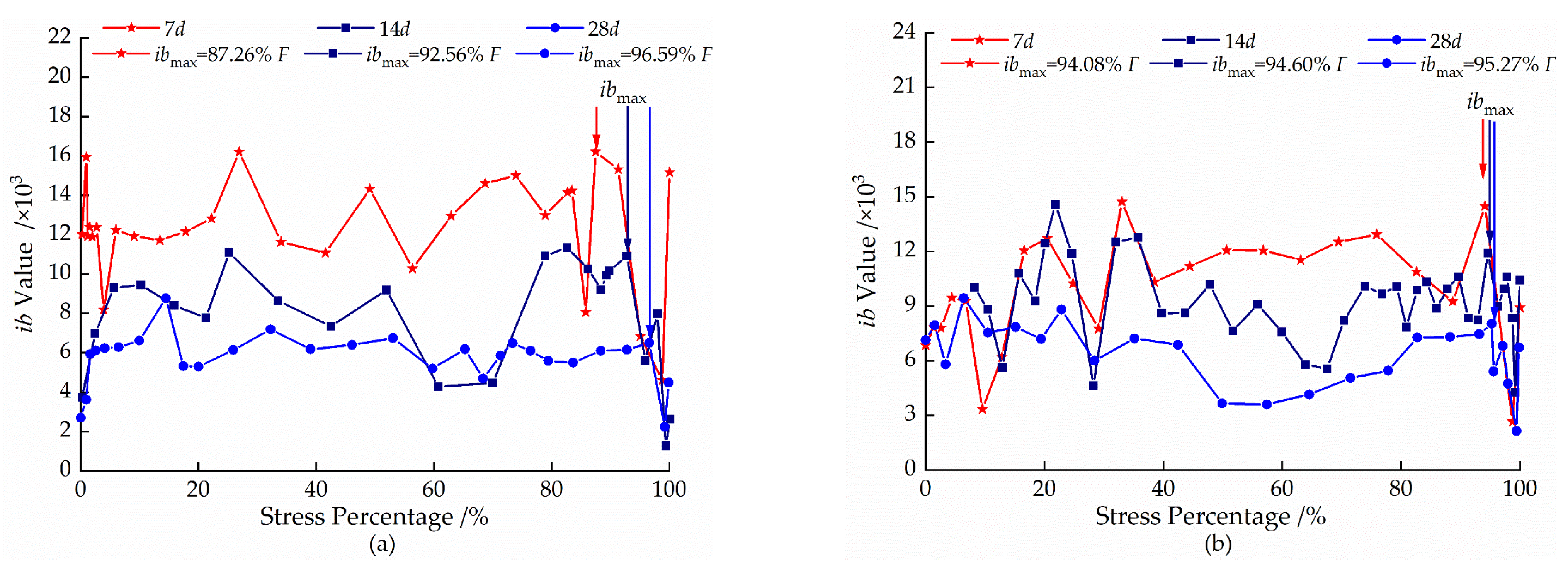
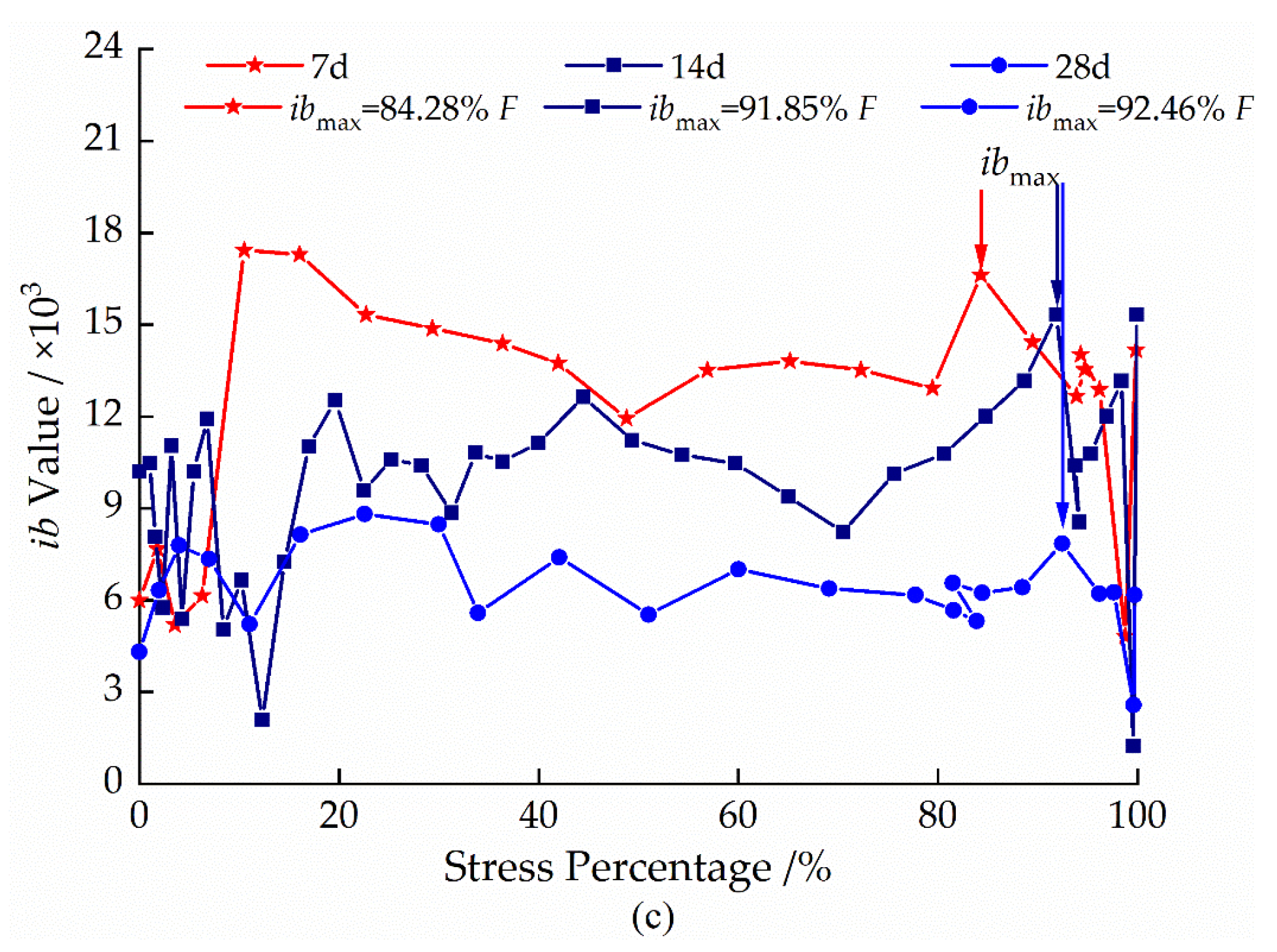
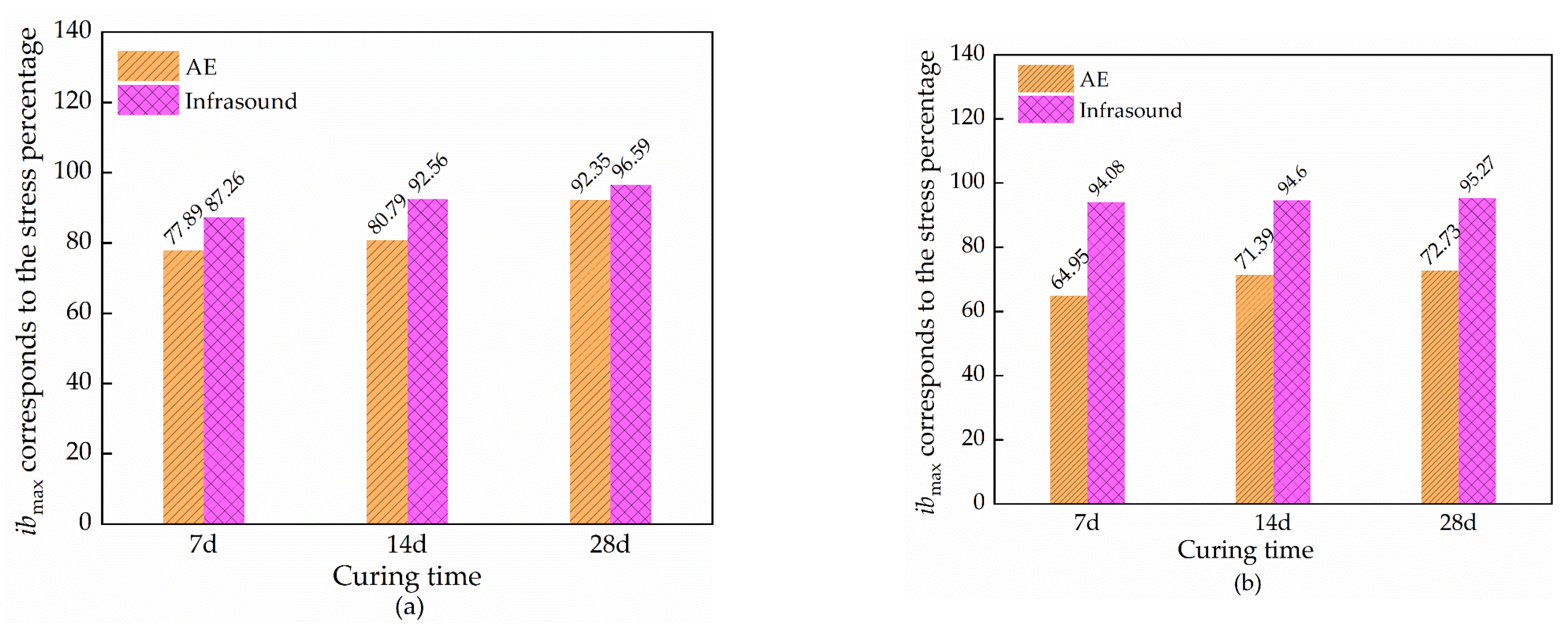

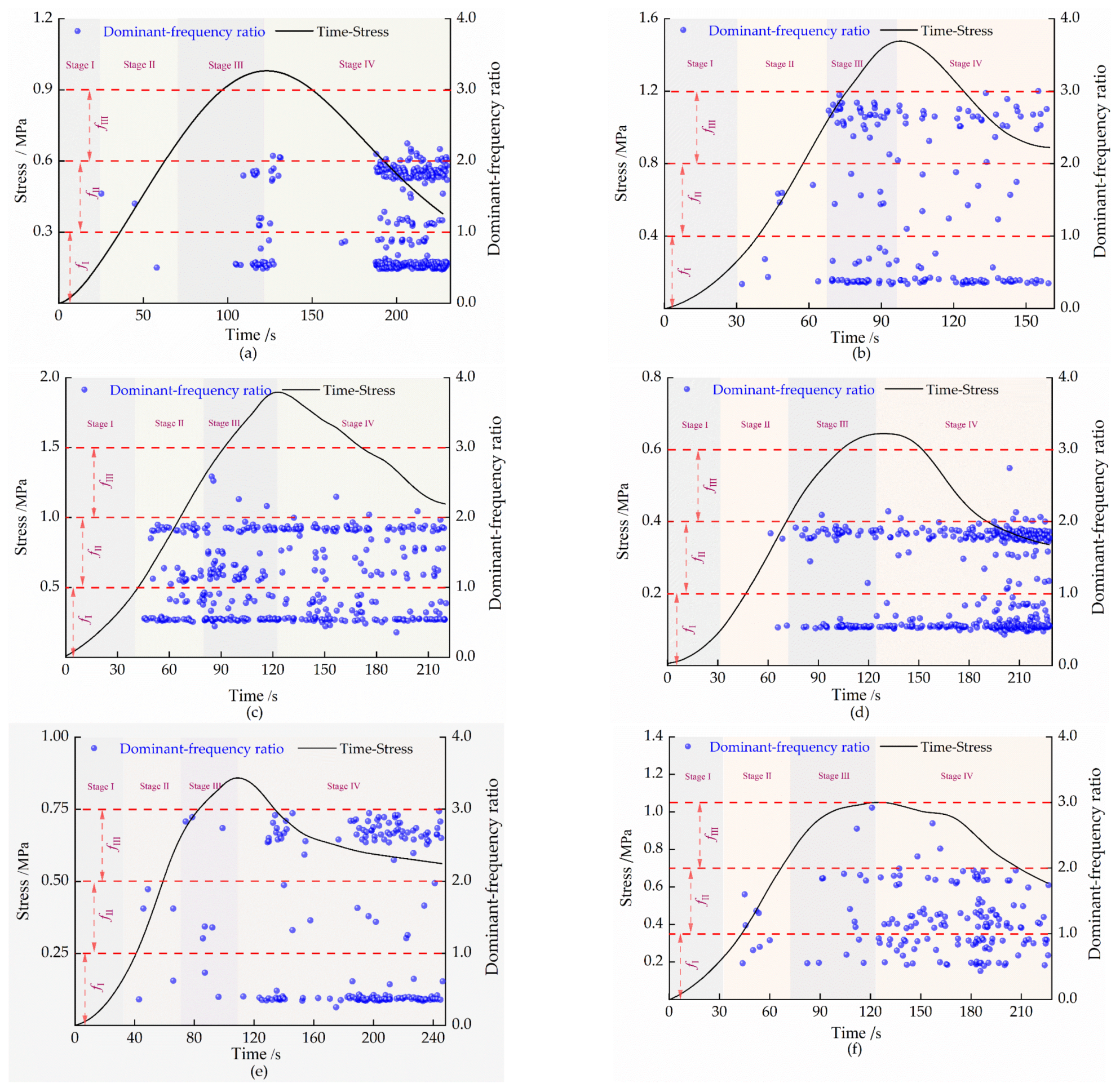
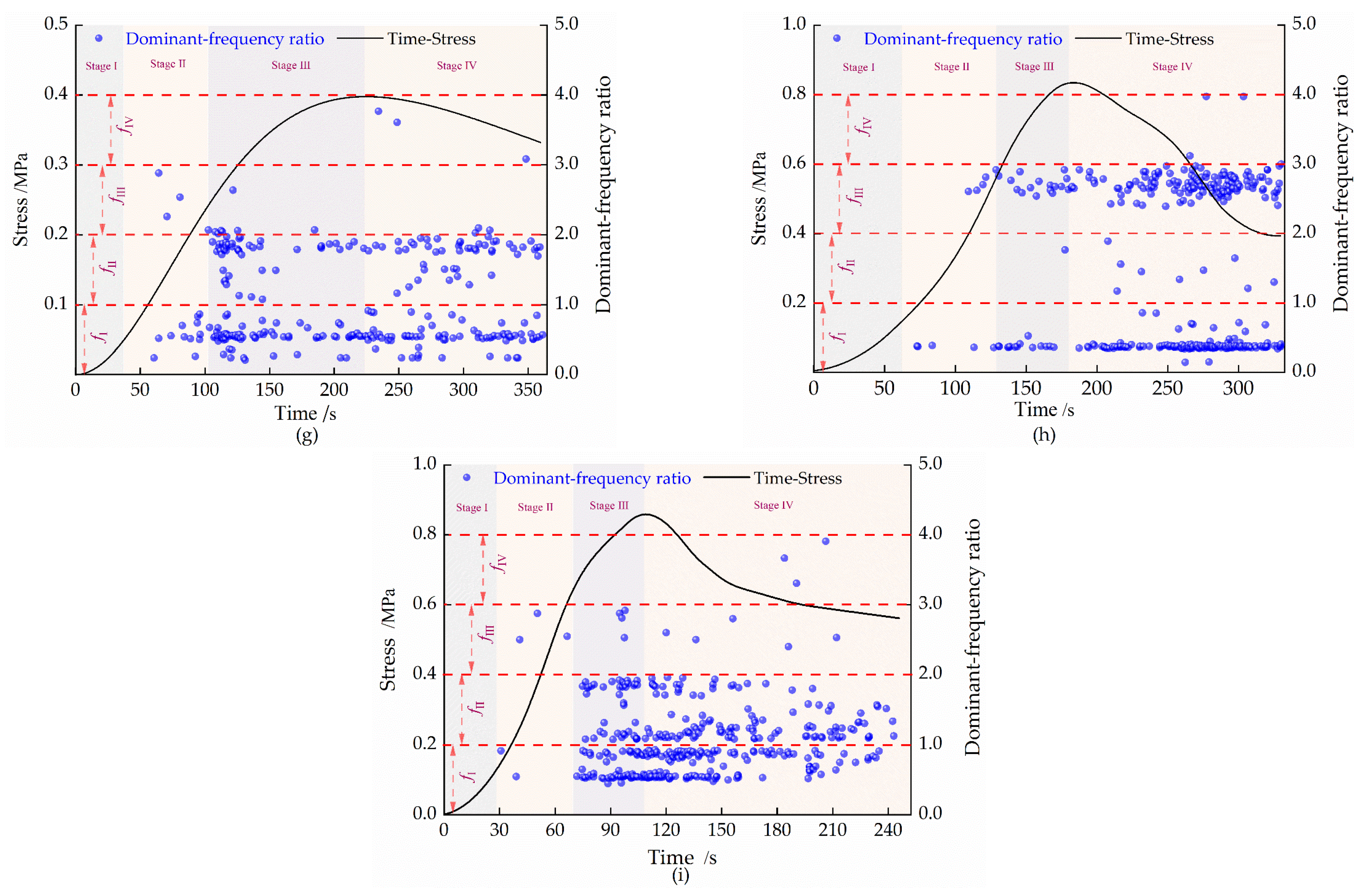

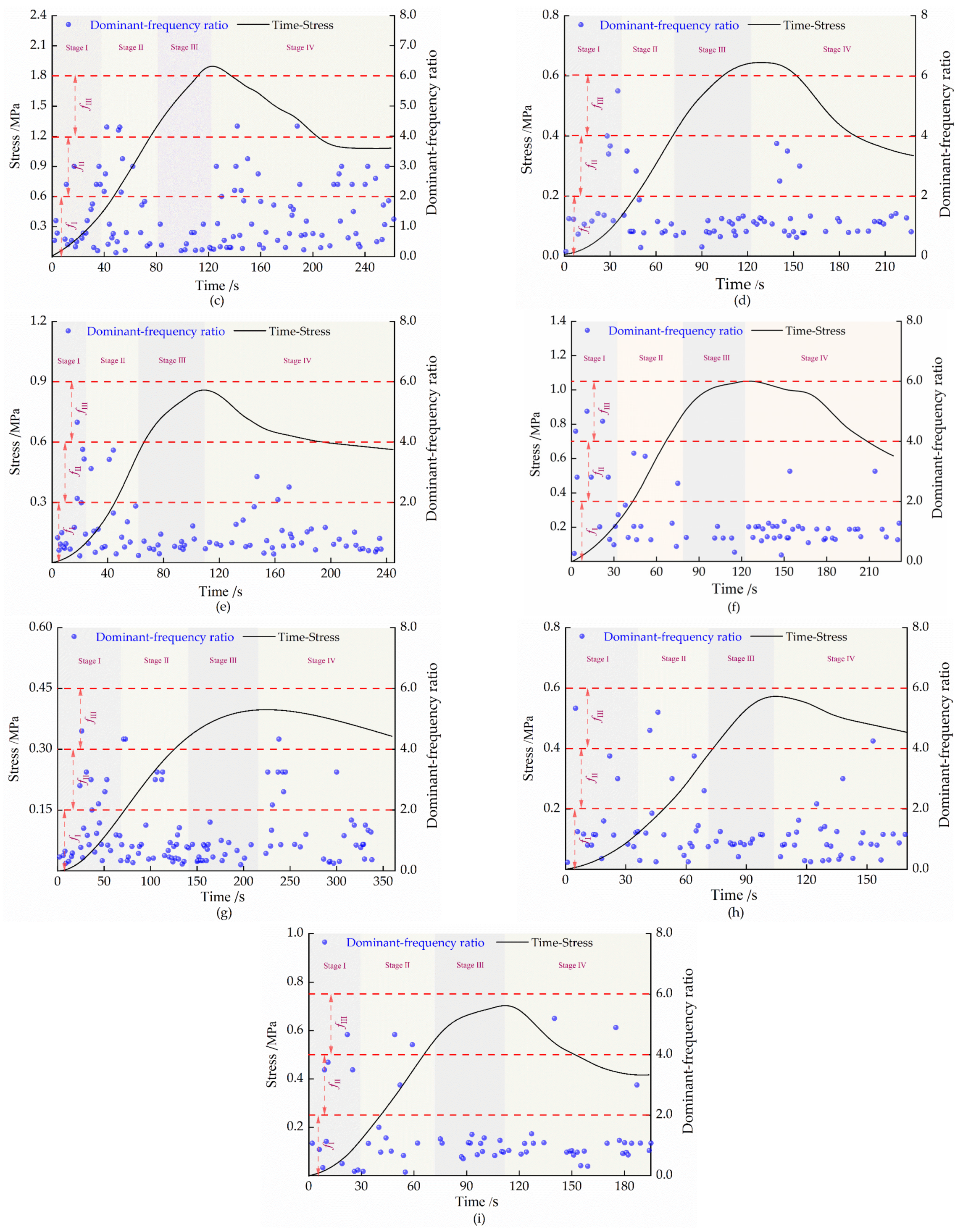
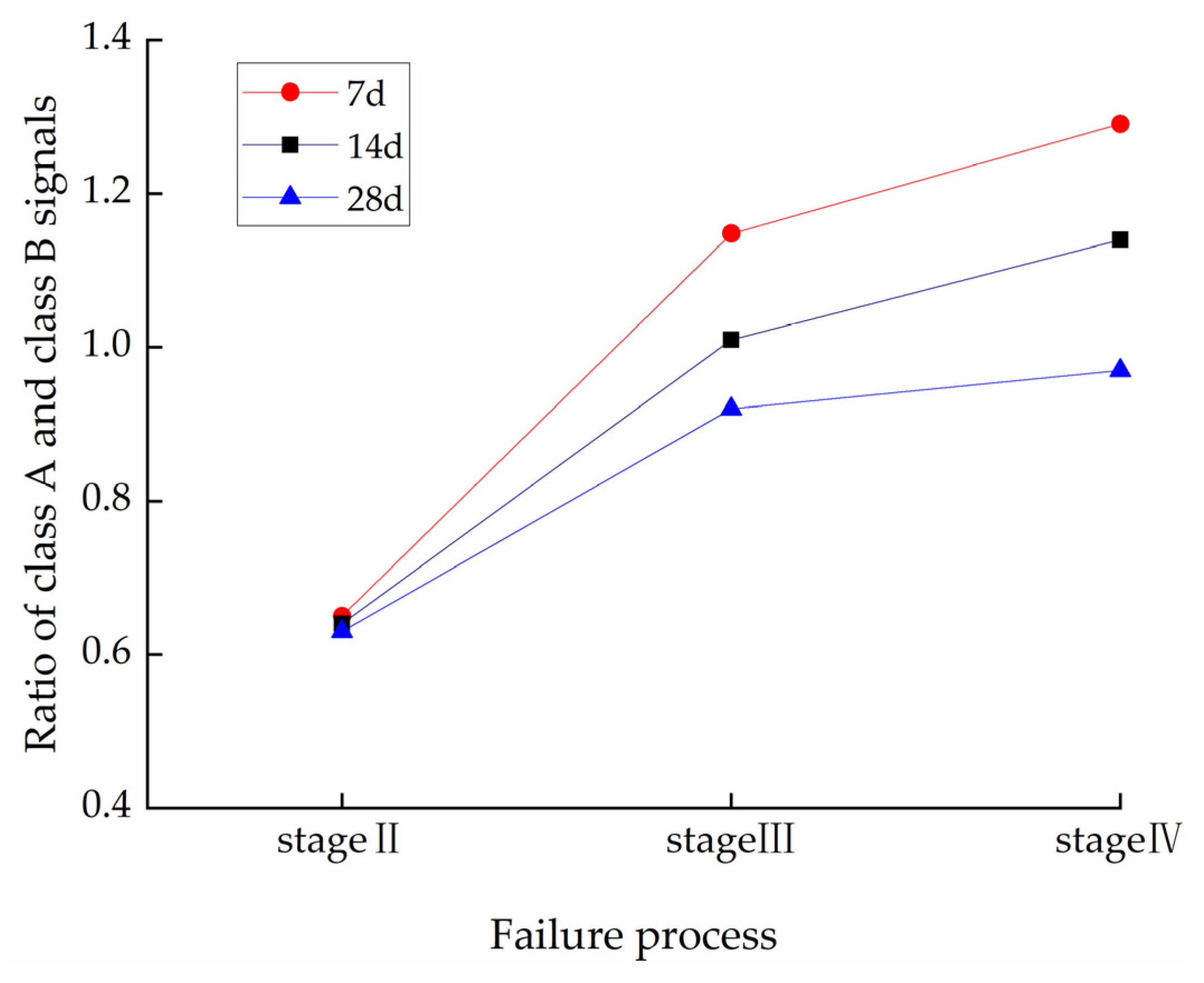

Disclaimer/Publisher’s Note: The statements, opinions and data contained in all publications are solely those of the individual author(s) and contributor(s) and not of MDPI and/or the editor(s). MDPI and/or the editor(s) disclaim responsibility for any injury to people or property resulting from any ideas, methods, instructions or products referred to in the content. |
© 2023 by the authors. Licensee MDPI, Basel, Switzerland. This article is an open access article distributed under the terms and conditions of the Creative Commons Attribution (CC BY) license (https://creativecommons.org/licenses/by/4.0/).
Share and Cite
Zhao, K.; Li, W.; Ding, H.; Zeng, P.; Xiang, W.; Zhang, M.; Liu, Z.; Li, Y. Experimental Study on the Mechanical and Acoustic Characteristics of Cemented Backfill with Unclassified Tailings at Different Curing Ages under Uniaxial Compression. Sustainability 2023, 15, 7177. https://doi.org/10.3390/su15097177
Zhao K, Li W, Ding H, Zeng P, Xiang W, Zhang M, Liu Z, Li Y. Experimental Study on the Mechanical and Acoustic Characteristics of Cemented Backfill with Unclassified Tailings at Different Curing Ages under Uniaxial Compression. Sustainability. 2023; 15(9):7177. https://doi.org/10.3390/su15097177
Chicago/Turabian StyleZhao, Kui, Wenhui Li, Hui Ding, Peng Zeng, Weibin Xiang, Min Zhang, Zhouchao Liu, and Yanda Li. 2023. "Experimental Study on the Mechanical and Acoustic Characteristics of Cemented Backfill with Unclassified Tailings at Different Curing Ages under Uniaxial Compression" Sustainability 15, no. 9: 7177. https://doi.org/10.3390/su15097177
APA StyleZhao, K., Li, W., Ding, H., Zeng, P., Xiang, W., Zhang, M., Liu, Z., & Li, Y. (2023). Experimental Study on the Mechanical and Acoustic Characteristics of Cemented Backfill with Unclassified Tailings at Different Curing Ages under Uniaxial Compression. Sustainability, 15(9), 7177. https://doi.org/10.3390/su15097177





